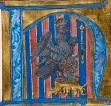 On 1st September 1532, at a ceremony at Windsor Castle, Henry VIII made Anne Boleyn Marquis of Pembroke, a title in her own right. The purpose of the granting of the title was to ‘fit’ Anne for the European stage, in readiness for the couple’s upcoming meeting with King Francis I of France. Henry and Anne were seeking his recognition and approval of their relationship and his support for the annulment of Henry VIII’s marriage to Catherine of Aragon.
On 1st September 1532, at a ceremony at Windsor Castle, Henry VIII made Anne Boleyn Marquis of Pembroke, a title in her own right. The purpose of the granting of the title was to ‘fit’ Anne for the European stage, in readiness for the couple’s upcoming meeting with King Francis I of France. Henry and Anne were seeking his recognition and approval of their relationship and his support for the annulment of Henry VIII’s marriage to Catherine of Aragon.
You can read more about the ceremony and the valuation of the lands granted to Anne Boleyn as part of her title in my article from 2012 – 1 September 1532 – Anne Boleyn Created Marquis of Pembroke